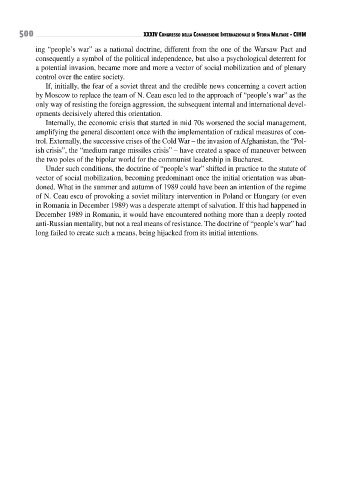Page 500 - Conflitti Militari e Popolazioni Civili - Tomo I
P. 500
500 XXXIV Congresso della CommIssIone InternazIonale dI storIa mIlItare • CIHm
ing “people’s war” as a national doctrine, different from the one of the Warsaw Pact and
consequently a symbol of the political independence, but also a psychological deterrent for
a potential invasion, became more and more a vector of social mobilization and of plenary
control over the entire society.
If, initially, the fear of a soviet threat and the credible news concerning a covert action
by Moscow to replace the team of N. Ceaučescu led to the approach of “people’s war” as the
only way of resisting the foreign aggression, the subsequent internal and international devel-
opments decisively altered this orientation.
Internally, the economic crisis that started in mid 70s worsened the social management,
amplifying the general discontent once with the implementation of radical measures of con-
trol. Externally, the successive crises of the Cold War – the invasion of Afghanistan, the “Pol-
ish crisis”, the “medium range missiles crisis” – have created a space of maneuver between
the two poles of the bipolar world for the communist leadership in Bucharest.
Under such conditions, the doctrine of “people’s war” shifted in practice to the statute of
vector of social mobilization, becoming predominant once the initial orientation was aban-
doned. What in the summer and autumn of 1989 could have been an intention of the regime
of N. Ceaučescu of provoking a soviet military intervention in Poland or Hungary (or even
in Romania in December 1989) was a desperate attempt of salvation. If this had happened in
December 1989 in Romania, it would have encountered nothing more than a deeply rooted
anti-Russian mentality, but not a real means of resistance. The doctrine of “people’s war” had
long failed to create such a means, being hijacked from its initial intentions.

